15 minutes of setup today. Start receiving alerts by tomorrow.
That's the quick-start guide to Metaplane's data observability platform. But how good can something this simple really be?
Let's find out.
What Is Metaplane?
Metaplane by Datadog is an ultra-lightweight, metadata-driven observability platform. Like its meatier enterprise-scale counterparts, it promises to prevent, detect, and resolve data quality issues across your entire data stack.
But with Metaplane, the size and complexity of your stack matter. A lot.
Metaplane is predicated on a radically different assumption: self-service observability isn't a compromise.
It's the strategy.
- Product-led onboarding
- Freemium access, including a tier for solo data engineers
- Workflows designed so analysts, data engineers, or managers can handle setup autonomously
- Feedback loops via Slack and usage analytics
Just connect your warehouse, BI tool, and dbt repo, and within minutes, Metaplane's monitors whirl to life. Within a day or two, alerts start landing in Slack.
There's no service contract. No specialized integration. You don’t even need a credit card to get started.
Metaplane's ML engine is optimized for self-service: it learns from historical metadata and adjusts automatically as patterns evolve. No manual thresholds or fine-tuning to fuss over. Even the UI is designed so analysts can triage issues on their own without engineering or platform team support.
Simple? Yes. Effective? Maybe.
It all depends on your size, need, and resources available to deal with the data quality issues the platform unearths.
Who's Metaplane For?
Metaplane's self-service model is convenient for teams starting small, moving quickly, and proving value without waiting for executive buy-in or enterprise-paced procurement.
But the trade-offs show up fast. There's no infrastructure monitoring. Lineage is limited. And root cause tooling provides more of a head start than a finish line.
For organizations with complex pipelines, regulatory exposure, or cross-functional data ownership, Metaplane may lack the depth and breadth desired.
The same simplicity that makes startup easy becomes a complication as your data stack matures.
So who can actually benefit from Metaplane?
- Lean data teams where the same person might own modeling, dashboards, and quality checks
- Nonprofits and NGOs that monitor critical data with minimal engineering expertise or support
- dbt-centric shops where transformation logic is modular and version-controlled
- Budget-conscious teams wary of the expense of traditional enterprise observability tools
- Stacks built on Snowflake, BigQuery, dbt, and BI tools like Looker or Mode
Metaplane clearly delivers on what it promises. It's just that its promises are few.
While the recent Datadog acquisition may expand Metaplane's capabilities over time, today's product remains firmly positioned for smaller, more straightforward use cases.
Its core features confirm this.
Features
Metaplane offers several features to build a pretty full data observability.
Monitoring and Anomaly Detection
Metaplane's monitoring kicks in fast. Its ML model learns from metadata alone, needing no thresholds and reading no raw data.
Group-by monitors and suggested coverage simplify setup, and alerts land in Slack with helpful charts and quick feedback options.
It's smooth, a light-lift, and you'll see patterns emerge by day two.
But the platform doesn't go much deeper. There's no incident correlation, impact scoring, and little visibility into how far issues spread downstream. Alert fatigue is common during onboarding, and the issue’s business impact is largely absent.
The result? A stream of urgent and irrelevant anomalies with no clear way to tell them apart.
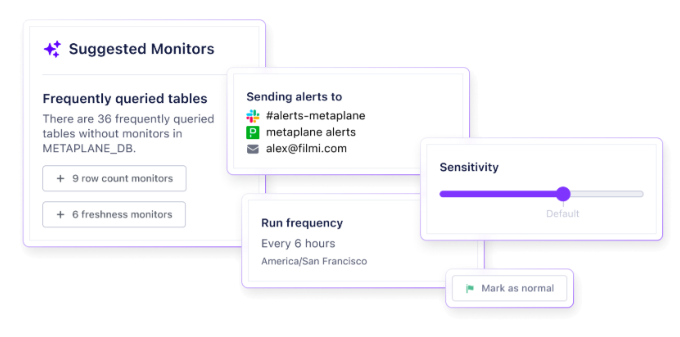
Data Lineage
Metaplane auto-generates column-level lineage across warehouses and BI tools, mapping how data flows from raw tables to dbt models to dashboards.
It's clean, automatically updated, and requires no manual configuration. This is great for quick impact checks and lightweight root cause workflows.
But it stops at surface-level flow. There's no quality overlay, no visibility into transformation logic, and no way to assess data health within the graph itself. It answers "what depends on this?" but not "why did this break?"
For simple questions, it helps. For deeper diagnostics, it's not quite enough.
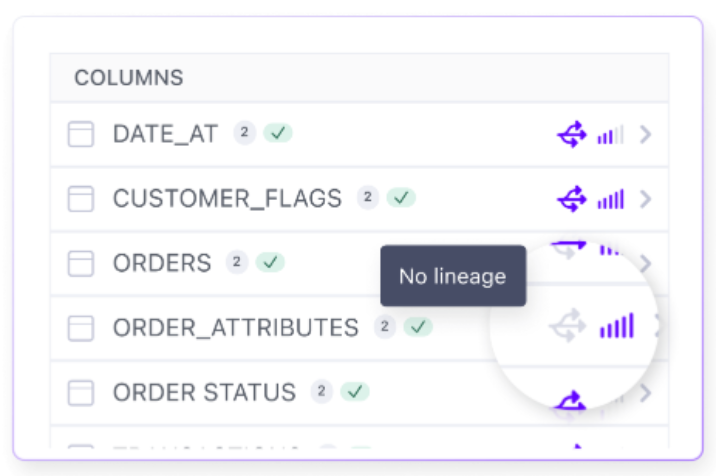
Data CI/CD
Metaplane extends useful observability into development with its built-in CI/CD support for dbt. When a pull request opens, it forecasts downstream impact, flagging affected tables, models, and dashboards, and runs automated regression tests to catch structural changes before they reach production.
Tightly integrated with GitHub and dbt Cloud/Core, the solution provides in-PR previews, impact maps, and incident-aware baselines. Metaplane's goal is prevention, not just detection. And it largely succeeds.
For dbt-native teams, it's a strong feature. But outside that ecosystem, the value drops fast. There's no support for Airflow, Spark, or custom pipelines, and tests are limited to metadata, ignoring logic, usage, or business risk.
It's a solid safety net for dbt merges. But as a broader QA framework, it's somewhat limited.

Schema Change Alerts
Metaplane tracks real-time schema changes, capturing added, removed, renamed, or retyped fields at the schema, table, and column levels. Alerts are automatically routed, even for unmonitored tables, and destinations are customizable by database, schema, or Slack channel.
This is one of the platform's sharper features. Coverage is broad, setup is zero-effort, and alerts are genuinely helpful, particularly when nulls or volume shifts stem from upstream edits.
But it's still metadata-only. There's no visibility into how changes affect joins, business rules, or query logic. No policy enforcement, no approval gating, no handoff to downstream owners.
For small teams, it's a reliable tripwire. But it's too reactive and surface-level to prevent real breakage in governed stacks or complex transformation layers.
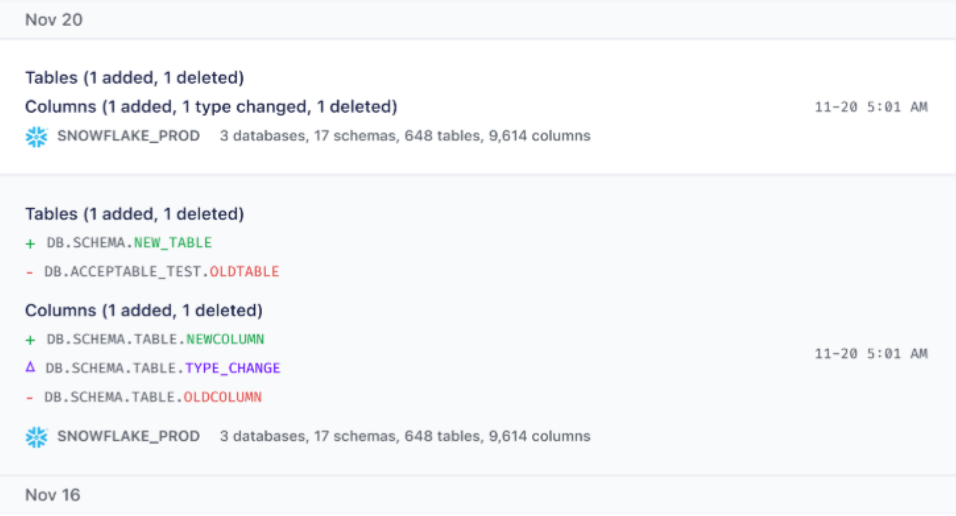
Alerting and Data Insights
Metaplane routes data quality alerts and schema change notifications directly to Slack, Teams, email, or PagerDuty.
Each alert includes incident charts, column-level lineage, and feedback buttons to mark issues as expected, recurring, or resolved. Suggested monitors help expand coverage, and alert grouping helps to keep the noise down.
For small teams, it's efficient. Alerts are clear, targeted, and actionable, and there's no need to log into the UI. The Data Insights view adds lightweight usage metrics like top queries and most-touched tables to help prioritize monitoring.
But there's no impact scoring, trust score correlation, or SLA tracking. Alerting is reactive, not policy-driven. And while Slack delivery is slick, there's no true incident lifecycle; just notifications with context, but no ownership or follow-through.
Metaplane's features are fast, clean, and easy to use. They cover the basics well but rarely go deep. There's just enough coverage to flag issues, but not enough to diagnose or prevent them in complex pipelines.

Where DoesMetaplane Fit in a Data Platform?
Metaplane sits lightly between your warehouse, transformation layer, and BI tools.
It connects to Snowflake, BigQuery, Redshift, and Databricks via metadata APIs; integrates natively with dbt Core and Cloud; and supports BI platforms like Looker, Mode, Metabase, Power BI, and Tableau.
Its architecture is entirely read-only and metadata-driven. There's no ingestion, performance impact, or access to raw data. That keeps setup quick and compliance straightforward.
In modern, modular stacks built on cloud warehouses, dbt, and Slack, Metaplane fits cleanly. But in more complex platforms, the seams begin to show. There's no awareness of orchestration tools like Airflow or Dagster, minimal catalog integration, and limited ability to customize observability logic beyond what's available in the UI or dbt tests.
It's a brilliant overlay for simple, modern stacks. But for platforms with layered transformations, legacy systems, or varied domains, Metaplane's architectural limits start to get in the way.
So how does it hold up in practice?
What Metaplane’s Users Say
We analyzed 100+ user reviews across G2 and Capterra to understand how Metaplane performs in real environments.
⭐⭐⭐⭐⭐ G2 4.85/ | Capterra 5/5
Metaplane earns consistent praise for doing exactly what it promises: getting teams from zero to monitoring in record time. Users highlight fast onboarding, seamless Slack integration, and immediate time savings.
The self-service experience lives up to the pitch.
Reviewers describe Metaplane support as responsive, knowledgeable, and unusually quick to act on feedback; rare recognition in this space.
But even in glowing reviews, its ceiling is noted.
Alert fatigue is a recurring theme, especially during the first few weeks. Several users mention that excessive noise led teams to ignore real issues. Others point to thin lineage views and limited customization compared to more mature platforms.
In short, users are impressed as long as their needs align with the product's design.
For small, fast-moving teams, Metaplane delivers.
Here's what these real user reviews suggested as Metaplane's strengths and opportunities:
Pros
Strong marks for simplicity, speed, and early value. It's well-suited to small teams that need visibility fast without engineering overhead.
- Setup is speedy, with most users reporting signup to monitoring in under 30 minutes.
- Real data issues appear within the first day or two, validating the platform's promise of quick time-to-value.
- The Slack integration is a highlight, delivering alert context, trend charts, and feedback options in a channel-friendly format.
- Its metadata-only architecture keeps deployments lightweight and secure, with no raw data access and minimal warehouse load.
- CI/CD integration with dbt adds practical utility, running regression tests and showing downstream impact during pull requests.
Cons
But that same simplicity creates limits.
- Alerts lack impact scoring, severity tiers, or downstream impact, forcing teams to triage everything manually.
- Root cause analysis is limited to basic context; it flags symptoms, but doesn't explain why issues happened or how to resolve them.
- Lineage is automatic but thin, illustrating flow but without health, logic layers, or transformation detail.
- Alert fatigue is common during onboarding, with noisy monitors and little initial tuning control.
- Customization is minimal. Few options exist for ownership, workflow configuration, or integration beyond the core stack.
- For platforms with orchestration tools, multi-hop pipelines, or compliance mandates, Metaplane's architecture may not scale far enough.
So, based on everything we've learned, Metaplane's value is clear. But so are its boundaries.
Let's examine where it fits best and when to consider a more robust alternative.
Is Metaplane the Right Fit for You?
Metaplane is a solid pick for small teams with simple stacks. Setup is quick, alerts land fast, and the self-service model avoids enterprise friction.
Setup speed remains unmatched in its category. But many teams outgrow it just as quickly.
Yet, for companies that need more than the basics, Sifflet is a better choice.
It's fast to deploy, but designed for long-term maturity:
- Always-on lineage: Field-level, real-time, and enriched with business semantics
- Smart alerting with context: Every alert carries technical root cause, downstream impact, and affected owners
- Agentic AI: Sentinel detects. Sage explains. Forge recommends. You act faster, with confidence
- Policy-driven governance: Align observability with SLAs, enforce rules, and track accountability across domains
Sifflet scales observability into proactive, business-aware trust with a setup that's almost as fast, and with depth you can build on.





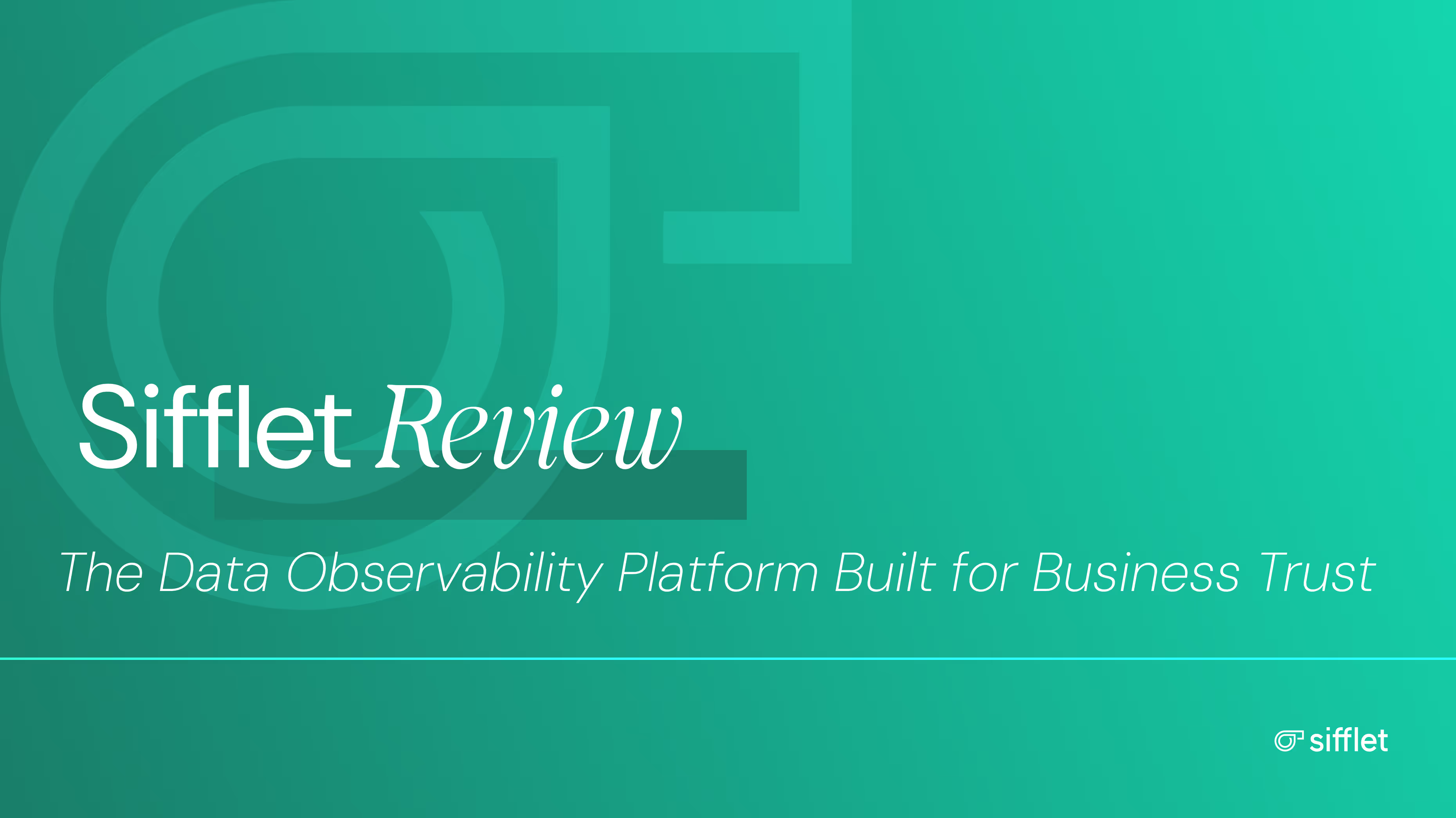
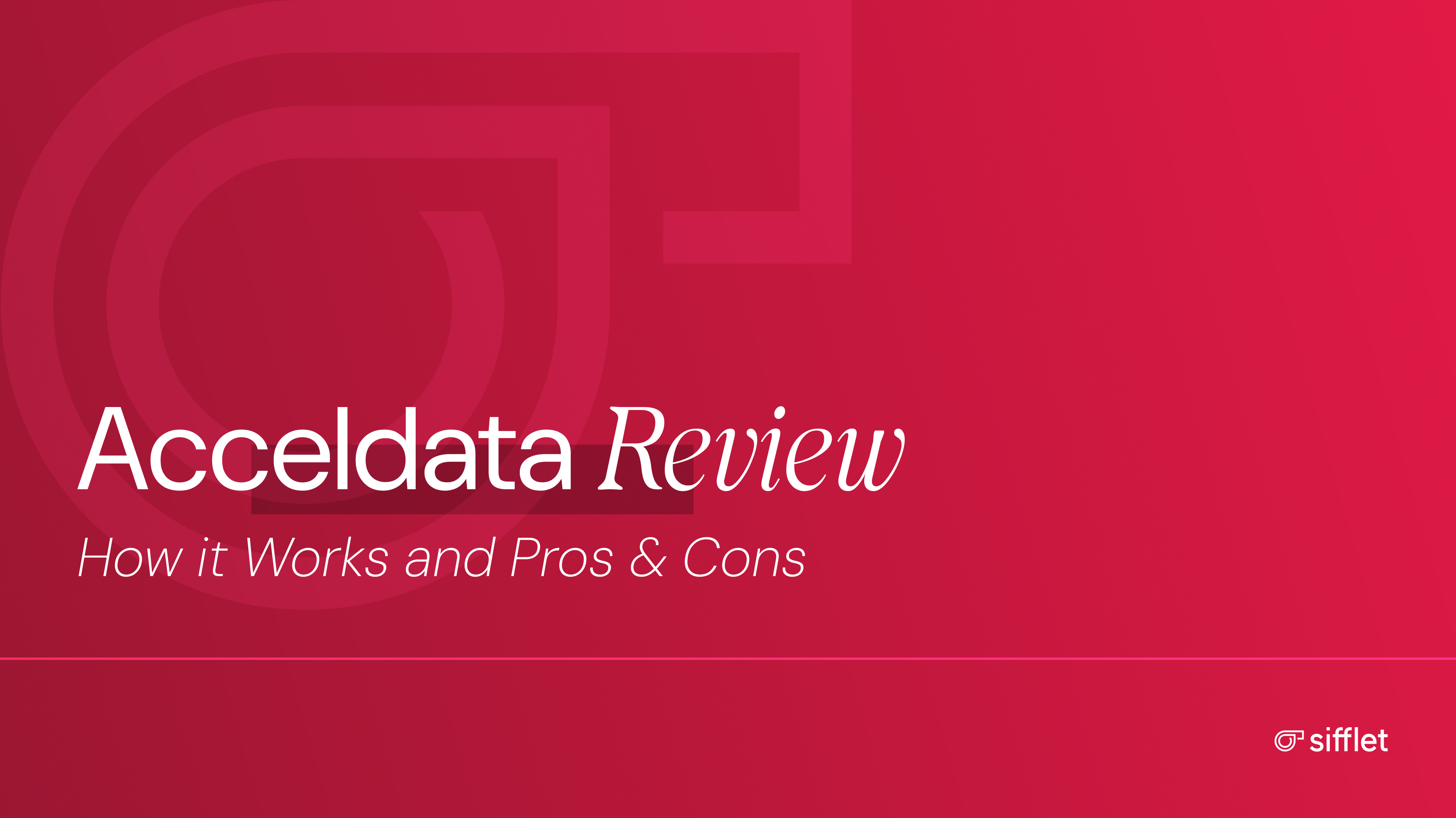
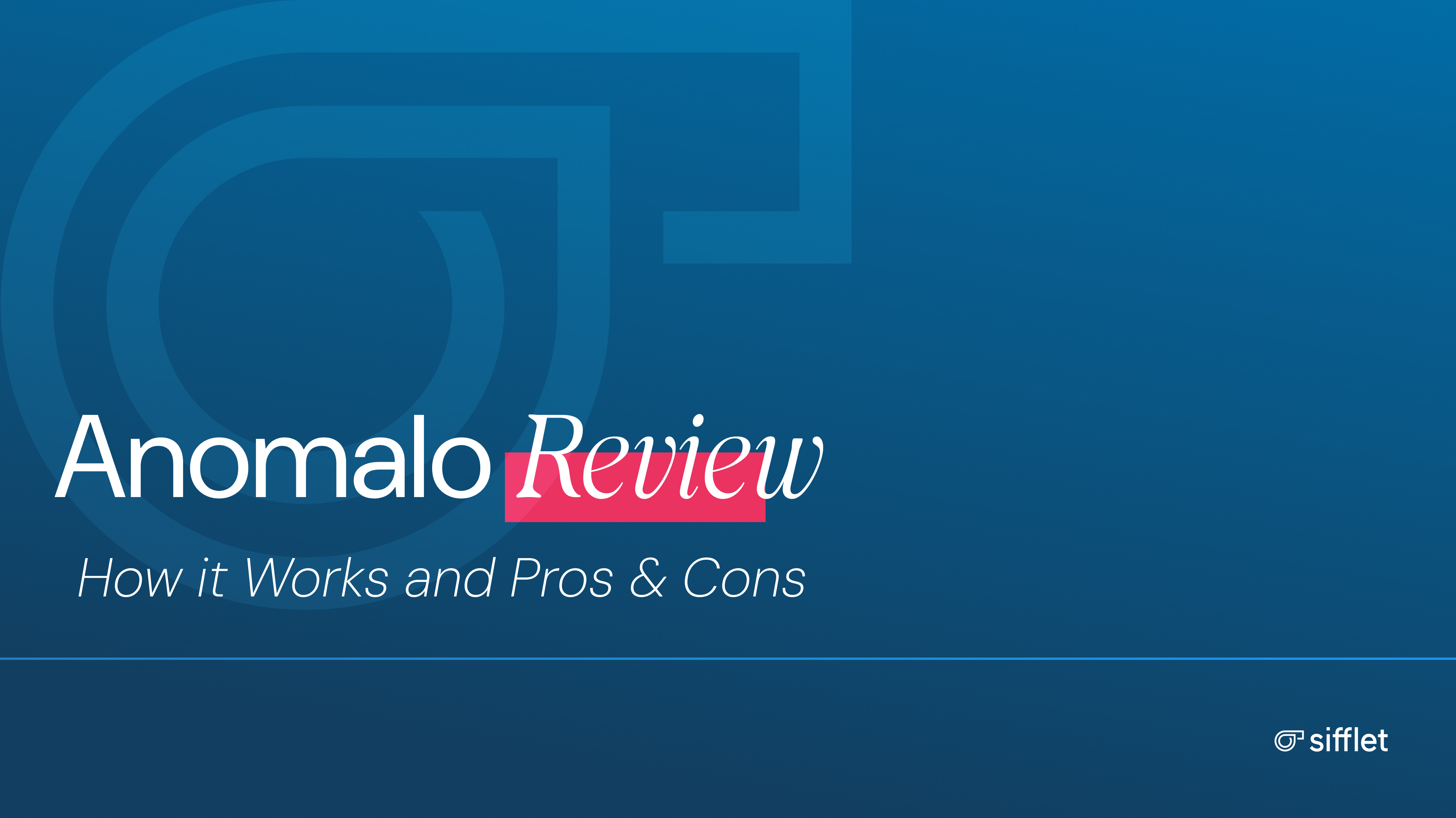













-p-500.png)
